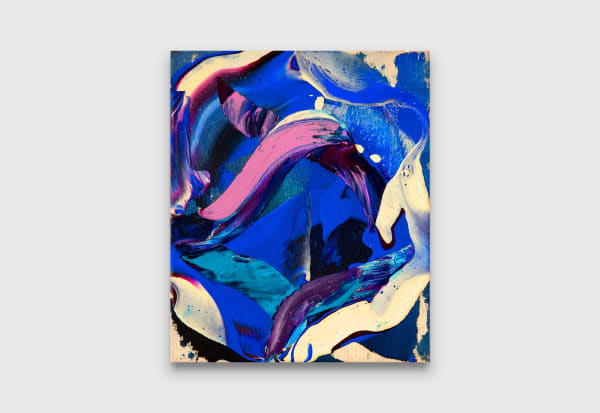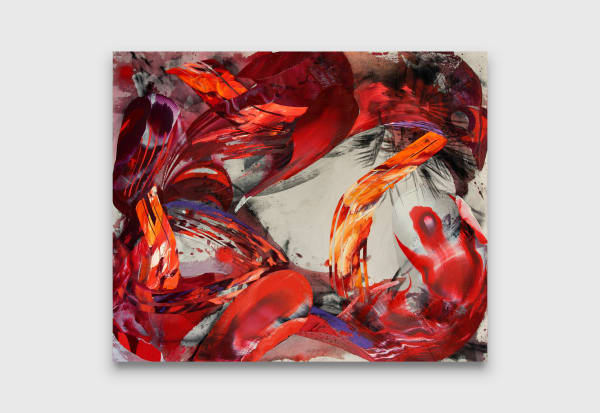Fabian Ramírez: An Eye Turned In
-
COMA is pleased to present a solo presentation, titled ‘An Eye Turned In’, by Dusseldorf-based Mexican artist Fabian Ramírez, on view 3 June – 9 July, 2022 in the gallery. This is the artist’s first solo exhibition with COMA.
‘An eye turned in’ is the depiction of image-ecstasy. The body of work collected in this exhibition explores the connection between the existence of this peculiar state (ἔκστασις) and image itself, delving into the meanings this phenomenon could entail in order to clarify the existence of the pictorial image. The title of this exhibition evokes the movement of the eye in an inward direction, indicating not only a gaze that turns its back on the exterior, but referring to a subject who experiences an altered perception and, with it, an unknown image. In Mayan-language, the word ecstasy (sa’at óol) not only refers to the rapture produced by such a state, but to the connection ecstasy has with energy, health, and clarity, also implying to lose oneself, to disappear. In any case, it means a will (óol) that could be called “the will to merge with the invisible”, becoming one with an entity who manifests itself as an “image of the imperceptible”. As opposed to how ecstasy is usually interpreted as a physical state of ultimate joy, or a delirium provoked by a subjective exaltation, focusing on the sensory aspect in terms of intensity, the exhibition attempts to approach the notion that arises from the Mayan tradition and its closeness to the invisible.
Read More -
 Fabian Ramírez
Fabian Ramírez
The Gates Of Xibalba/Thunderbolt, 2022
acrylic and oil on canvas
240 x 200 cm / 94 1/2 x 78 3/4 inchesHowever, this invisibility we refer to is not only due to the human condition itself. Those things which are not seen remain ignored and are considered inferior and therefore non-existent. Altogether with the “image of the imperceptible” is also the silenced image of that indigenous vision of a world that becomes present, even if only in a fugitive form. History pretends to be the compilation and categorization of what we know in order to create a general narrative of what “we have been”, a generic image in which the invisible it is overshadowed.
The experience of ecstasy as a recognition and confrontation of the invisible and ignored is itself a process of death that allows for healing. In the same way that a shaman who initiates himself in the techniques of ecstasy sees his image burn in flames to emerge to a new healed life, this generic image we are speaking about, needs to be burned, making the image of otherness emerge, redeeming it from the depths of the culture where it remains buried. In that sense, this project revisits some of the fundamental elements for modern art such as the “notion of image” and “abstraction”, in order to point out the unacknowledged aspects of it, and the connection it has with some indigenous concepts.
-
Artworks
-

-
 Fabian Ramírez in his studio in Kunstakademie Düsseldorf, Dusseldorf, Germany, 2022 Photo by Nada MalešSince image represents a central phenomenon to humanity, it is precisely the origin of images what constitutes one of the fundamental enigmas to solve, not only to understand the being, but its existence within the universe. Therefore, rethinking the abstract image and its presence in art not only means to acknowledge how the ancestral thought is filtered through its image in a modernized form, but at the same time it also represents a possibility of confronting the modern perspective with the approximation and closeness that the indigenous world has with the origin, which is prolonged over time because of its ancestral meaning.
Fabian Ramírez in his studio in Kunstakademie Düsseldorf, Dusseldorf, Germany, 2022 Photo by Nada MalešSince image represents a central phenomenon to humanity, it is precisely the origin of images what constitutes one of the fundamental enigmas to solve, not only to understand the being, but its existence within the universe. Therefore, rethinking the abstract image and its presence in art not only means to acknowledge how the ancestral thought is filtered through its image in a modernized form, but at the same time it also represents a possibility of confronting the modern perspective with the approximation and closeness that the indigenous world has with the origin, which is prolonged over time because of its ancestral meaning. -
Installation Views

















